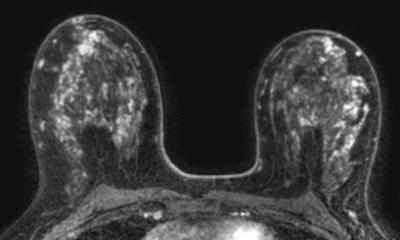A new dimension
Stereoscopic digital mammography
Stereoscopic digital mammography, a new diagnostic technique capable of producing three-dimensional (3-D) in-depth views of breast tissue, could significantly reduce the number of women who are recalled for additional tests following routine screening mammography.
Results of a clinical trial being conducted at Emory University Breast Clinic, in Atlanta, were presented at the annual meeting of the Radiological Society of North America (RSNA).
‘Standard mammography is one of the most difficult radiographic exams to interpret,’ said David J Getty PhD, division scientist at BBN Technologies of Cambridge, Mass. `In a two-dimensional image of the breast, subtle lesions may be masked by underlying or overlying normal tissue and thus be missed, and normal tissue scattered at different depths can align to mimic a lesion, leading to false-positive detections.’
Stereoscopic digital mammography consists of two digital X-ray images of the breast acquired from two different points of view separated by about eight degrees. When the images are viewed on a stereo display workstation, the radiologist can see the internal structure of the breast in 3-D. In the ongoing clinical trial, researchers use a full-field digital mammography unit modified to take stereo pairs of images. The workstation enables the mammographer to fuse the stereo image pair and to view the breast in depth. ‘Stereo viewing is the only way to see the structure within the breast volume in true depth,’ said Dr Getty, who has worked on the development of this technology for the last 12 years.
As of July 2007, 1,093 patients at elevated risk for developing breast cancer were enrolled in the trial. Each patient received a full-field, standard digital mammography screening examination and a full-field, stereoscopic digital exam, which were then read independently by different radiologists.
A total of 259 suspicious findings were detected by the combined mammography procedures and referred for additional diagnostic testing, including biopsy when indicated. Of those, 109 were determined to be true lesions. Standard mammography missed 40 of the 109 lesions while the stereoscopic exam failed to detect 24.
‘Our early results suggest that stereo digital mammography could contribute to the earlier detection of cancer,’ Dr Getty pointed out. ‘A small percentage of the additional lesions missed by standard mammography but detected by stereoscopic mammography will turn out to be cancerous.’
Of the 259 findings, 150 were false positives, meaning further testing revealed that no abnormality was present. Standard mammography yielded 103 false positives; stereo mammography yielded 53.
`In our study, stereo digital mammography reduced false positives by 49 percent,’ said Dr Getty. `This could have a significant impact by halving the number of women who are needlessly recalled for additional diagnostic work-ups, resulting in a large savings in cost and patient anxiety.`
By the end of the clinical trial this December, 1,500 women at elevated risk of developing breast cancer will have received both the stereo and standard digital mammography screening examinations.
Offering wide-scale stereoscopic digital mammography would entail minor changes to digital mammography equipment and software, Dr Getty added.
Source: RSNA
31.12.2007











